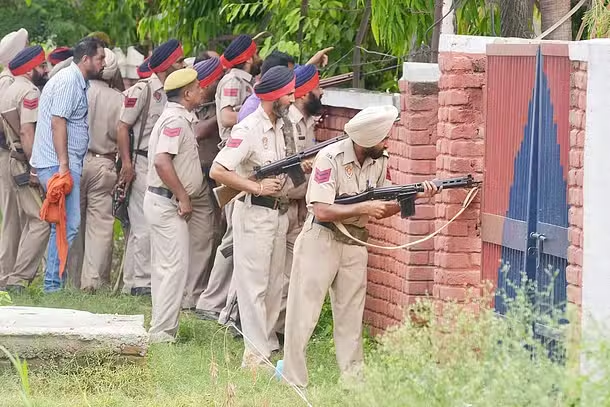In a significant operation that underscores the relentless efforts of Indian security forces against militancy, three suspected Khalistani terrorists, allegedly involved in the recent grenade attack on a police post in Gurdaspur, Punjab, were neutralized in an encounter in Pilibhit, Uttar Pradesh. The operation not only marks a tactical victory but also raises questions about the resurgence of Khalistani activities and their broader implications for national security.
The Encounter: A Tactical Success
The encounter occurred early on Saturday morning when a joint team of Uttar Pradesh Police’s Special Task Force (STF) and local law enforcement cornered the suspects in a forested area near Pilibhit. Acting on specific intelligence inputs, the team tracked the movements of the individuals identified as Varinder Singh alias Ravi, Gurwinder Singh, and Jaspreet Singh alias Pratap Singh. The trio was reportedly armed and resisted arrest, leading to a firefight that ended with their deaths.
During the operation, security forces recovered two AK-47 rifles, two Glock pistols, and a significant cache of ammunition. According to officials, the weapons and logistical support suggested that the suspects had international backing, potentially from Pakistan-based handlers linked to the Inter-Services Intelligence (ISI).
The Gurdaspur Attack: A Timeline
The three men were allegedly involved in the grenade attack on the Bakshiwala police post in Gurdaspur on December 18, 2024. The attack, which caused structural damage but no casualties, was aimed at destabilizing the region and inciting fear. Investigations revealed that the attack was part of a larger plot orchestrated by the Khalistan Zindabad Force (KZF), a banned outfit advocating for a separate Sikh state.
The use of high-grade explosives and the precision of the operation pointed to extensive planning and external support. Preliminary probes have linked the group to earlier incidents of violence in Punjab, reinforcing concerns about the revival of Khalistani militancy in the region.
Regional and National Implications
The encounter highlights the increasing sophistication of militant operations in India’s northern states. Punjab, a state with a history of insurgency during the 1980s and 1990s, has seen a resurgence of Khalistani rhetoric in recent years. This revival is attributed to diaspora-funded propaganda, social media campaigns, and alleged support from foreign intelligence agencies.
Experts warn that these developments could destabilize the region, particularly in the context of Punjab’s strategic location and its role as a border state. “The re-emergence of Khalistani elements is not just a local law-and-order issue. It’s a national security challenge that requires a coordinated response across states and agencies,” said a senior counterterrorism expert.
The Role of ISI and International Networks
Investigations into the Gurdaspur attack and the subsequent encounter suggest that the suspects were part of a transnational network with links to Pakistan’s ISI. Intelligence reports indicate that the KZF, along with other Khalistani groups, has been receiving financial and logistical support from abroad. The ISI’s involvement is seen as part of a broader strategy to destabilize India by exploiting religious and regional fault lines.
“The recovery of sophisticated weapons like AK-47s and Glocks indicates the scale of support these groups are receiving. This isn’t just about reviving Khalistan; it’s about creating chaos and undermining India’s internal security,” said an official familiar with the case.
Public Reaction and Political Ramifications
The encounter has drawn widespread attention, with many praising the swift action of law enforcement agencies. However, it has also reignited debates about the approach to handling insurgency and the need for community engagement to counter radicalization.
Punjab’s political leadership has called for a united front against terrorism. “We cannot let a few individuals disrupt the peace and harmony of our state. The people of Punjab have suffered enough, and we must ensure that history does not repeat itself,” said a senior minister in the Punjab government.
Meanwhile, civil society organizations have emphasized the importance of addressing the root causes of radicalization, including economic grievances, unemployment, and the influence of diaspora groups. “While security operations are necessary, we also need to win the hearts and minds of people to prevent the spread of extremist ideologies,” said a human rights activist.
Future Challenges and Strategies
The encounter in Pilibhit is a reminder of the complex challenges India faces in combating terrorism. Experts have called for a multi-pronged strategy that includes:
- Enhanced Intelligence Sharing: Strengthening coordination between central and state agencies to preempt militant activities.
- Border Security: Tightening surveillance along the India-Pakistan border to prevent the smuggling of arms and explosives.
- Community Engagement: Building trust with local communities to counter radicalization and foster cooperation with law enforcement.
- International Cooperation: Working with global partners to dismantle funding and propaganda networks operating from abroad.
Conclusion
The elimination of three Khalistani terrorists in Uttar Pradesh marks a critical success for Indian security forces, but it also underscores the enduring threat posed by militant groups. As the nation grapples with these challenges, a comprehensive and inclusive approach will be essential to ensuring long-term peace and stability. The encounter serves as a stark reminder of the vigilance required to safeguard the country from emerging threats.
Also Read-1. Bangladesh Sends Diplomatic Note to India Seeking Sheikh Hasina’s Return: 3 Key Implications
2. Ex-IAS Trainee Puja Khedkar Denied Pre-Arrest Bail: 5 Key Points to Know
Reference- To know more Click Here.














1 thought on “3 Khalistani Terrorists Killed in UP Encounter: Key Details and Implications”